A Review of Natural Fiber-Based Filaments for 3D Printing: Filament Fabrication and Characterization
Abstract
:1. Introduction
2. Material Preparation
3. Extrusion Process
3.1. Single-Screw Extruder
3.2. Twin-Screw Extruder
4. Dimensional Stability and Printability
5. Characterization of Wire Filament
5.1. Mechanical and Physical Properties
5.2. Morphology and Surface Quality
6. Challenges in Developing a Fiber Composite Filament
7. Conclusions and Future Perspectives
Author Contributions
Funding
Institutional Review Board Statement
Informed Consent Statement
Data Availability Statement
Acknowledgments
Conflicts of Interest
Abbreviations
References
- Parandoush, P.; Lin, D. A review on additive manufacturing of polymer-fiber composites. Compos. Struct. 2017, 182, 36–53. [Google Scholar] [CrossRef]
- Ning, F.; Cong, W.; Qiu, J.; Wei, J.; Wang, S. Additive manufacturing of carbon fiber reinforced thermoplastic composites using fused deposition modeling. Compos. Part B Eng. 2015, 80, 369–378. [Google Scholar] [CrossRef]
- Mazzanti, V.; Malagutti, L.; Mollica, F. FDM 3D Printing of Polymers Containing Natural Fillers: A Review of their Mechanical Properties. Polymers 2019, 11, 1094. [Google Scholar] [CrossRef] [PubMed]
- Durfee, K.; Iaizzo, P.A. Medical Applications of 3D Printing. In Engineering in Medicine; Chapter 21; Elsevier Ltd.: Duxford, UK, 2019; pp. 495–509. [Google Scholar]
- Visser, C.W.; Pohl, R.; Sun, C.; Romer, G.W.; Huis in’t Veld, B.; Lohse, D. Toward 3D Printing of Pure Metals by Laser-Induced Forward Transfer. Adv. Mater. 2015, 27, 4087–4092. [Google Scholar] [CrossRef]
- Jain, A.; Mathur, T.; Pandian, N.K.; Selahi, A. Organ-on-a-chip and 3D printing as preclinical models for medical research and practice. In Precision Medicine for Investigators, Practitioners and Providers; Chapter 9; Elsevier Ltd.: Duxford, UK, 2020; pp. 83–95. [Google Scholar] [CrossRef]
- Rouf, S.; Malik, A.; Singh, N.; Raina, A.; Naveed, N.; Siddiqui, M.I.H.; Haq, M.I.U. Additive manufacturing technologies: Industrial and medical applications. Sustain. Oper. Comput. 2022, 3, 258–274. [Google Scholar] [CrossRef]
- Kumaresan, R.; Samykano, M.; Kadirgama, K.; Sharuzi, W.; Harun, W.; Rahman, M. Fused deposition modeling: Process, materials, parameters, properties, and applications. Int. J. Adv. Manuf. Technol. 2022, 120, 1531–1570. [Google Scholar]
- Vaidya, A.A.; Collet, C.; Gaugler, M.; Lloyd-Jones, G. Integrating softwood bio refinery lignin into polyhydroxybutyrate composites and application in 3D printing. Mater. Today Commun. 2019, 19, 286–296. [Google Scholar] [CrossRef]
- Nguyen, N.A.; Bowland, C.C.; Naskar, A.K. A general method to improve 3D-printability and inter-layer adhesion in lig-nin-based composites. Appl. Mater. Today 2018, 12, 138–152. [Google Scholar] [CrossRef]
- Potter, P.M.; Al-Abed, S.R.; Lay, D.; Lomnicki, S.M. VOC Emissions and Formation Mechanisms from Carbon Nanotube Composites during 3D Printing. Environ. Sci. Technol. 2019, 53, 4364–4370. [Google Scholar] [CrossRef]
- Chen, Z.; Li, Z.; Li, J.; Liu, C.; Lao, C.; Fu, Y.; Liu, C.; Li, Y.; Wang, P.; He, Y. 3D printing of ceramics: A review. J. Eur. Ceram. Soc. 2019, 39, 661–687. [Google Scholar] [CrossRef]
- Zhang, D.; Jonhson, W.; Herng, T.S.; Ang, Y.Q.; Yang, L.; Tan, S.C.; Peng, E.; He, H.; Ding, J. A 3D-printing method of fabrication for metals, ceramics, and multi-materials using a universal self-curable technique for robocasting. Mater. Horiz. 2020, 7, 1083–1090. [Google Scholar] [CrossRef]
- Ligon, S.C.; Liska, R.; Stampfl, J.; Gurr, M.; Mülhaupt, R. Polymers for 3D Printing and Customized Additive Manufacturing. Chem. Rev. 2017, 117, 10212–10290. [Google Scholar] [CrossRef]
- Cicala, G.; Giordano, D.; Tosto, C.; Filippone, G.; Recca, A.; Blanco, I. Polylactide (PLA) Filaments a Biobased Solution for Additive Manufacturing: Correlating Rheology and Thermomechanical Properties with Printing Quality. Materials 2018, 11, 1191. [Google Scholar] [CrossRef]
- Wang, K.; Cai, R.; Zhang, Z.; Liu, J.; Ahzi, S.; Peng, Y.; Rao, Y. Compressive behaviors of 3D printed polypropylene-based composites at low and high strain rates. Polym. Test. 2021, 103, 107321. [Google Scholar] [CrossRef]
- Cicala, G.; Ognibene, G.; Portuesi, S.; Blanco, I.; Rapisarda, M.; Pergolizzi, E.; Recca, G. Comparison of Ultem 9085 Used in Fused Deposition Modelling (FDM) with Polytherimide Blends. Materials 2018, 11, 285. [Google Scholar] [CrossRef]
- Ahmad, M.N.; Tarmeze, A.A.; Rasib, A.H.A. Capability of 3D Printing Technology in Producing Molar Teeth Prototype. Int. J. Eng. Appl. 2020, 8, 64. [Google Scholar] [CrossRef]
- Ahmad, M.N.; Ishak, M.R.; Mohammad Taha, M.; Mustapha, F.; Leman, Z.; Anak Lukista, D.D.; Ghazali, I. Application of Taguchi method to optimize the parameter of fused deposition modeling (FDM) using oil palm fiber reinforced thermo-plastic composites. Polymers 2022, 14, 2140. [Google Scholar] [CrossRef]
- Suteja, J.; Firmanto, H.; Soesanti, A.; Christian, C. Properties investigation of 3D printed continuous pineapple leaf fiber re-inforced PLA composite. J. Thermoplast. Compos. Mater. 2022, 35, 2052–2061. [Google Scholar] [CrossRef]
- Tao, Y.; Wang, H.; Li, Z.; Li, P.; Shi, S.Q. Development and Application of Wood Flour-Filled Polylactic Acid Composite Filament for 3D Printing. Materials 2017, 10, 339. [Google Scholar] [CrossRef]
- Liu, H.; He, H.; Peng, X.; Huang, B.; Li, J. Three-dimensional printing of poly(lactic acid) bio-based composites with sugarcane bagasse fiber: Effect of printing orientation on tensile performance. Polym. Adv. Technol. 2019, 30, 910–922. [Google Scholar] [CrossRef]
- Osman, M.A.; Atia, M.R. Investigation of ABS-rice straw composite feedstock filament for FDM. Rapid Prototyp. J. 2018, 24, 1067–1075. [Google Scholar] [CrossRef]
- Milosevic, M.; Stoof, D.; Pickering, K.L. Characterizing the Mechanical Properties of Fused Deposition Modelling Natural Fiber Recycled Polypropylene Composites. J. Compos. Sci. 2017, 1, 7. [Google Scholar] [CrossRef]
- Safka, J.; Ackermann, M.; Bobek, J.; Seidl, M.; Habr, J.; Behalek, L. Use of composite materials for FDM 3Dprint technology. Mater. Sci. Forum 2016, 862, 174–181. [Google Scholar] [CrossRef]
- Asim, M.; Saba, N.; Jawaid, M.; Nasir, M. Potential of natural fiber/biomass filler-reinforced polymer composites in aerospace applications. In Sustainable Composites for Aerospace Applications; Jawaid, M., Thariq, M., Eds.; Woodhead Publishing: Sawston, UK, 2018; pp. 253–268. [Google Scholar] [CrossRef]
- De Oliveira, A.S.; de Macedo, N.J.R.; Rosa, D.S. Eco-efficiency of Poly (lactic acid)-Starch-Cotton composite with high natural cotton fiber content: Environmental and functional value. J. Clean. Prod. 2019, 217, 32–41. [Google Scholar] [CrossRef]
- Chen, G.; Luo, H. Effects of node with discontinuous hierarchical fibers on the tensile fracture behaviors of natural bamboo. Sustain. Mater. Technol. 2020, 26, e00228. [Google Scholar] [CrossRef]
- Wang, X.; Jiang, M.; Zhou, Z.W.; Gou, J.H.; Hui, D. 3D printing of polymer matrix composites: A review and prospective. Compos. Part B Eng. 2017, 110, 442–458. [Google Scholar] [CrossRef]
- Santoni, A.; Bonfiglio, P.; Fausti, P.; Marescotti, C.; Mazzanti, V.; Mollica, F.; Pompoli, F. Improving the sound ab-sorption performance of sustainable thermal insulation materials: Natural hempfibres. Appl. Acoust. 2019, 150, 279–289. [Google Scholar] [CrossRef]
- Aida, H.J.; Nadlene, R.; Mastura, M.; Yusriah, L.; Sivakumar, D.; Ilyas, R.A. Natural fibre filament for Fused Deposition Modelling (FDM): A review. Int. J. Sustain. Eng. 2021, 14, 1988–2008. [Google Scholar] [CrossRef]
- Nasir, M.H.M.; Taha, M.M.; Razali, N.; Ilyas, R.A.; Knight, V.F.; Norrrahim, M.N.F. Effect of Chemical Treatment of Sugar Palm Fibre on Rheological and Thermal Properties of the PLA Composites Filament for FDM 3D Printing. Materials 2022, 15, 8082. [Google Scholar] [CrossRef]
- Ahmad, M.N.; Ishak, M.R.; Taha, M.M.; Mustapha, F.; Leman, Z. Irianto Mechanical, thermal and physical characteristics of oil palm (Elaeis guineensis) fiber reinforced thermoplastic composites for FDM—Type 3D printer. Polym. Test. 2023, 120, 107972. [Google Scholar] [CrossRef]
- Anand, P.B.; Lakshmikanthan, A.; Chandrashekarappa, M.P.G.; Selvan, C.P.; Pimenov, D.Y.; Giasin, K. Experimental Investigation of Effect of Fiber Length on Mechanical, Wear, and Morphological Behavior of Silane-Treated Pineapple Leaf Fiber Reinforced Polymer Composites. Fibers 2022, 10, 56. [Google Scholar] [CrossRef]
- Nuzaimah, M.; Sapuan, S.; Nadlene, R.; Jawaid, M. Sodium Hydroxide Treatment of Waste Rubber Crumb and Its Effects on Properties of Unsaturated Polyester Composites. Appl. Sci. 2020, 10, 3913. [Google Scholar] [CrossRef]
- Ahmad, M.N.; Ishak, M.R.; Taha, M.M.; Mustapha, F.; Leman, Z. Rheological and Morphological Properties of Oil Palm Fiber-Reinforced Thermoplastic Composites for Fused Deposition Modeling (FDM). Polymers 2021, 13, 3739. [Google Scholar] [CrossRef]
- Ahmed, W.; Alnajjar, F.; Zaneldin, E.; Al-Marzouqi, A.H.; Gochoo, M.; Khalid, S. Implementing FDM 3D Printing Strategies Using Natural Fibers to Produce Biomass Composite. Materials 2020, 13, 4065. [Google Scholar] [CrossRef]
- Xie, G.; Zhang, Y.; Lin, W. Plasticizer Combinations and Performance of Wood Flour–Poly(Lactic Acid) 3D Printing Filaments. Bioresources 2017, 12, 6736–6748. [Google Scholar] [CrossRef]
- Aumnate, C.; Soatthiyanon, N.; Makmoon, T.; Potiyaraj, P. Polylactic acid/kenaf cellulose biocomposite filaments for melt extrusion based-3D printing. Cellulose 2021, 28, 8509–8525. [Google Scholar] [CrossRef]
- Le Duigou, A.; Barbé, A.; Guillou, E.; Castro, M. 3D printing of continuous flax fibre reinforced biocomposites for structural applications. Mater. Des. 2019, 180, 107884. [Google Scholar] [CrossRef]
- Han, S.N.M.F.; Taha, M.M.; Mansor, M.R.; Rahman, M.A.A. Investigation of tensile and flexural properties of kenaf fiber-reinforced acrylonitrile butadiene styrene composites fabricated by fused deposition modeling. J. Eng. Appl. Sci. 2022, 69, 52. [Google Scholar] [CrossRef]
- Pereira, D.F.; Branco, A.; Cláudio, R.; Marques, A.C.; Figueiredo-Pina, C.G. Development of Composites of PLA Filled with Different Amounts of Rice Husk Fibers for Fused Deposition Modeling. J. Nat. Fibers 2023, 20, 2162183. [Google Scholar] [CrossRef]
- Patil, H.; Tiwari, R.V.; Repka, M.A. Hot-Melt Extrusion: From Theory to Application in Pharmaceutical Formulation. AAPS PharmSciTech 2016, 17, 20–42. [Google Scholar] [CrossRef]
- Gaspar-Cunha, A.; Covas, J.A.; Costa, M.; Fernanda, P.; Costa, L. Optimization of Single Screw Extrusion; Technicka Univerzita Kosice: Košice, Slovakia, 2018. [Google Scholar]
- Geus, H.-G. Developments in manufacturing techniques for technical nonwovens. In Advances in Technical Nonwovens; Woodhead Publishing: Sawston, UK, 2016; pp. 133–153. [Google Scholar] [CrossRef]
- Pitjamit, S.; Thunsiri, K.; Nakkiew, W.; Wongwichai, T.; Pothacharoen, P.; Wattanutchariya, W. The Possibility of Interlocking Nail Fabrication from FFF 3D Printing PLA/PCL/HA Composites Coated by Local Silk Fibroin for Canine Bone Fracture Treatment. Materials 2020, 13, 1564. [Google Scholar] [CrossRef] [PubMed]
- Singhal, S.; Lohar, V.K.; Arora, V. Hot Melt Extrusion Technique. Webmedcentral Pharm. Sci. 2011, 2, WMC001459. [Google Scholar]
- Maniruzzaman, M.; Boateng, J.S.; Snowden, M.J.; Douroumis, D. A Review of Hot-Melt Extrusion: Process Technology to Pharmaceutical Products. ISRN Pharm. 2012, 2012, 436763. [Google Scholar] [CrossRef] [PubMed]
- Censi, R.; Gigliobianco, M.R.; Casadidio, C.; Di Martino, P. Hot Melt Extrusion: Highlighting Physicochemical Factors to Be Investigated While Designing and Optimizing a Hot Melt Extrusion Process. Pharmaceutics 2018, 10, 89. [Google Scholar] [CrossRef]
- Tan, D.K.; Maniruzzaman, M.; Nokhodchi, A. Advanced Pharmaceutical Applications of Hot-Melt Extrusion Coupled with Fused Deposition Modelling (FDM) 3D Printing for Personalised Drug Delivery. Pharmaceutics 2018, 10, 203. [Google Scholar] [CrossRef]
- Ahmad, M.N.; Ishak, M.R.; Taha, M.M.; Mustapha, F.; Leman, Z. Investigation of ABS–oil palm fiber (Elaeis guineensis) composites filament as feedstock for fused deposition modeling. Rapid Prototyp. J. 2023, 29, 897–909. [Google Scholar] [CrossRef]
- Singh, R.; Kumar, R.; Ranjan, N. Sustainability of Recycled ABS and PA6 by Banana Fiber Reinforcement: Thermal, Mechanical and Morphological Properties. J. Inst. Eng. Ser. C 2019, 100, 351–360. [Google Scholar] [CrossRef]
- Girdis, J.; Gaudion, L.; Proust, G.; Löschke, S.; Dong, A. Rethinking Timber: Investigation into the Use of Waste Macadamia Nut Shells for Additive Manufacturing. JOM 2017, 69, 575–579. [Google Scholar] [CrossRef]
- Nafis, Z.A.S.; Nuzaimah, M.; Kudus, S.I.; Yusuf, Y.; Ilyas, R.A.; Knight, V.F.; Norrrahim, M.N.F. Effect of Wood Dust Fibre Treatments Reinforcement on the Properties of Recycled Polypropylene Composite (r-WoPPC) Filament for Fused Deposition Modelling (FDM). Materials 2023, 16, 479. [Google Scholar] [CrossRef]
- Scaffaro, R.; Gulino, E.F.; Citarrella, M.C.; Maio, A. Green Composites Based on Hedysarum coronarium with Outstanding FDM Printability and Mechanical Performance. Polymers 2022, 14, 1198. [Google Scholar] [CrossRef]
- Figueroa-Velarde, V.; Diaz-Vidal, T.; Cisneros-López, E.O.; Robledo-Ortiz, J.R.; López-Naranjo, E.J.; Ortega-Gudiño, P.; Rosales-Rivera, L.C. Mechanical and physicochemical properties of 3d-printed agave fibers/poly (Lactic) acid bio-composites. Materials 2021, 14, 3111. [Google Scholar] [CrossRef]
- Shahar, F.S.; Sultan, M.T.H.; Safri, S.N.A.; Jawaid, M.; Talib, A.R.A.; Basri, A.A.; Shah, A.U.M. Physical, thermal and tensile behaviour of 3D printed kenaf/PLA to suggest its usability for ankle–foot orthosis–a preliminary study. Rapid Prototyp. J. 2022, 28, 573–1588. [Google Scholar] [CrossRef]
- Jamadi, A.H.; Razali, N.; Petrů, M.; Taha, M.M.; Muhammad, N.; Ilyas, R.A. Effect of Chemically Treated Kenaf Fibre on Mechanical and Thermal Properties of PLA Composites Prepared through Fused Deposition Modeling (FDM). Polymers 2021, 13, 3299. [Google Scholar] [CrossRef]
- Yu, W.; Shi, J.; Sun, L.; Lei, W. Effects of Printing Parameters on Properties of FDM 3D Printed Residue of Astragalus/Polylactic Acid Biomass Composites. Molecules 2022, 27, 7373. [Google Scholar] [CrossRef]
- Fekete, I.; Ronkay, F.; Lendvai, L. Highly toughened blends of poly(lactic acid) (PLA) and natural rubber (NR) for FDM-based 3D printing applications: The effect of composition and infill pattern. Polym. Test. 2021, 99, 107205. [Google Scholar] [CrossRef]
- Depuydt, D.; Balthazar, M.; Hendrickx, K.; Six, W.; Ferraris, E.; Desplentere, F.; Ivens, J.; Van Vuure, A.W. Production and characterization of bamboo and flax fiber reinforced polylactic acid filaments for fused deposition modeling (FDM). Polym. Compos. 2019, 40, 1951–1963. [Google Scholar] [CrossRef]
- Dey, A.; Rahman, M.M.; Yodo, N.; Grewell, D. Development of Biocomposite Filament for Fused Filament Fabrication from Soy Hulls and Soy Protein Isolate. Mater. Today Commun. 2023, 34, 105316. [Google Scholar] [CrossRef]
- Wilczynski, K.; White, J.L. Melting model for intermeshing counter-rotating twin-screw extruders. Polym. Eng. Sci. 2003, 43, 1715–1726. [Google Scholar] [CrossRef]
- Bouvier, J.M.; Campanella, O.H. Extrusion Processing Technology: Food and Non-Food Biomaterials; John Wiley & Sons: Hoboken, NJ, USA, 2014. [Google Scholar]
- Crowley, M.M.; Zhang, F.; Repka, M.A.; Thumma, S.; Upadhye, S.B.; Battu, S.K.; McGinity, J.W.; Martin, C. Pharmaceutical Applications of Hot-Melt Extrusion: Part I. Drug Dev. Ind. Pharm. 2007, 33, 909–926. [Google Scholar] [CrossRef]
- Chaturvedi, E.; Rajput, N.S.; Upadhyaya, S.; Pandey, P.K. Experimental Study and Mathematical Modeling for Extrusion using High Density Polyethylene. Mater. Today Proc. 2017, 4, 1670–1676. [Google Scholar] [CrossRef]
- Angatkina, K. Recycling of HDPE from MSW Waste to 3D Printing Filaments. Ph.D. Thesis, Arcada University of Applied Science, Helsinki, Finland, 2018. [Google Scholar]
- Gkartzou, E.; Koumoulos, E.P.; Charitidis, C.A. Production and 3D printing processing of bio-based thermoplastic filament. Manuf. Rev. 2017, 4, 2016020. [Google Scholar] [CrossRef]
- Antony, S.; Cherouat, A.; Montay, G. Fabrication and Characterization of Hemp Fibre Based 3D Printed Honeycomb Sandwich Structure by FDM Process. Appl. Compos. Mater. 2020, 27, 935–953. [Google Scholar] [CrossRef]
- Graupner, N.; Ziegmann, G.; Wilde, F.; Beckmann, F.; Müssig, J. Procedural influences on compression and injection moulded cellulose fibre-reinforced polylactide (PLA) composites: Influence of fibre loading, fibre length, fibre orientation and voids. Compos. Part A Appl. Sci. Manuf. 2016, 81, 158–171. [Google Scholar] [CrossRef]
- Bellehumeur, C.; Li, L.; Sun, Q.; Gu, P. Modeling of bond formation between polymer filaments in the fused deposition modeling process. J. Manuf. Process. 2004, 6, 170–178. [Google Scholar] [CrossRef]
- Muck, D.; Tomc, H.G.; Elesini, U.S.; Ropret, M.; Leskovšek, M. Colour Fastness to Various Agents and Dynamic Mechanical Characteristics of Biocomposite Filaments and 3D Printed Samples. Polymers 2021, 13, 3738. [Google Scholar] [CrossRef]
- Le Duigou, A.; Castro, M.; Bevan, R.; Martin, N. 3D printing of wood fibre biocomposites: From mechanical to actuation functionality. Mater. Des. 2016, 96, 106–114. [Google Scholar] [CrossRef]
- Filgueira, D.; Holmen, S.; Melbø, J.K.; Moldes, D.; Echtermeyer, A.T.; Chinga-Carrasco, G. Enzymatic-assisted modification of thermomechanical pulp fibers to improve the interfacial adhesion with poly (lactic acid) for 3D printing. ACS Sustain. Chem. Eng. 2017, 5, 9338–9346. [Google Scholar] [CrossRef]
- Guo, R.; Ren, Z.; Bi, H.; Song, Y.; Xu, M. Effect of toughening agents on the properties of poplar wood flour/poly (lactic acid) composites fabricated with Fused Deposition Modeling. Eur. Polym. J. 2018, 107, 34–45. [Google Scholar] [CrossRef]
- Petchwattana, N.; Channuan, W.; Naknaen, P.; Narupai, B. 3D printing filaments prepared from modified poly (lactic acid)/teak wood flour composites: An investigation on the particle size effects and silane coupling agent compatibilisation. J. Physiol. Sci. JPS 2019, 30, 169–188. [Google Scholar] [CrossRef]
- Le Guen, M.-J.; Hill, S.; Smith, D.; Theobald, B.; Gaugler, E.; Barakat, A.; Mayer-Laigle, C. Influence of Rice Husk and Wood Biomass Properties on the Manufacture of Filaments for Fused Deposition Modeling. Front. Chem. 2019, 7, 735. [Google Scholar] [CrossRef]
- Hwang, S.; Reyes, E.I.; Moon, K.-S.; Rumpf, R.C.; Kim, N.S. Thermo-mechanical Characterization of Metal/Polymer Composite Filaments and Printing Parameter Study for Fused Deposition Modeling in the 3D Printing Process. J. Electron. Mater. 2014, 44, 771–777. [Google Scholar] [CrossRef]
- George, J.; Sreekala, M.S.; Thomas, S. A review on interface modification and characterization of natural fiber reinforced plastic composites. Polym. Eng. Sci. 2001, 41, 1471–1485. [Google Scholar] [CrossRef]
- Royan, N.R.R.; Leong, J.S.; Chan, W.N.; Tan, J.R.; Shamsuddin, Z.S.B. Current State and Challenges of Natural Fibre-Reinforced Polymer Composites as Feeder in FDM-Based 3D Printing. Polymers 2021, 13, 2289. [Google Scholar] [CrossRef]
- Khalid, M.Y.; Al Rashid, A.; Arif, Z.U.; Ahmed, W.; Arshad, H. Recent advances in nanocellulose-based different biomaterials: Types, properties, and emerging applications. J. Mater. Res. Technol. 2021, 14, 2601–2623. [Google Scholar] [CrossRef]

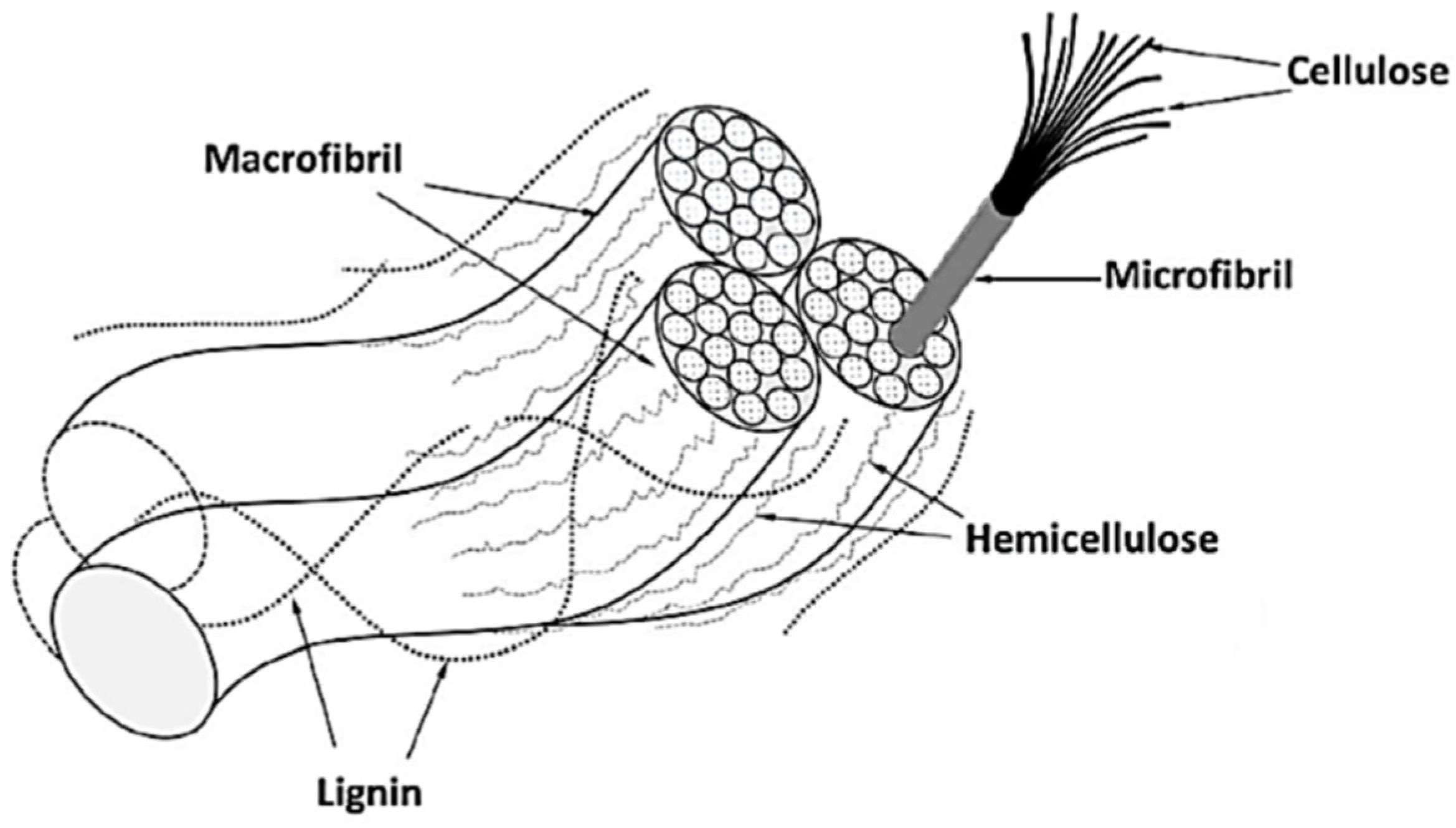
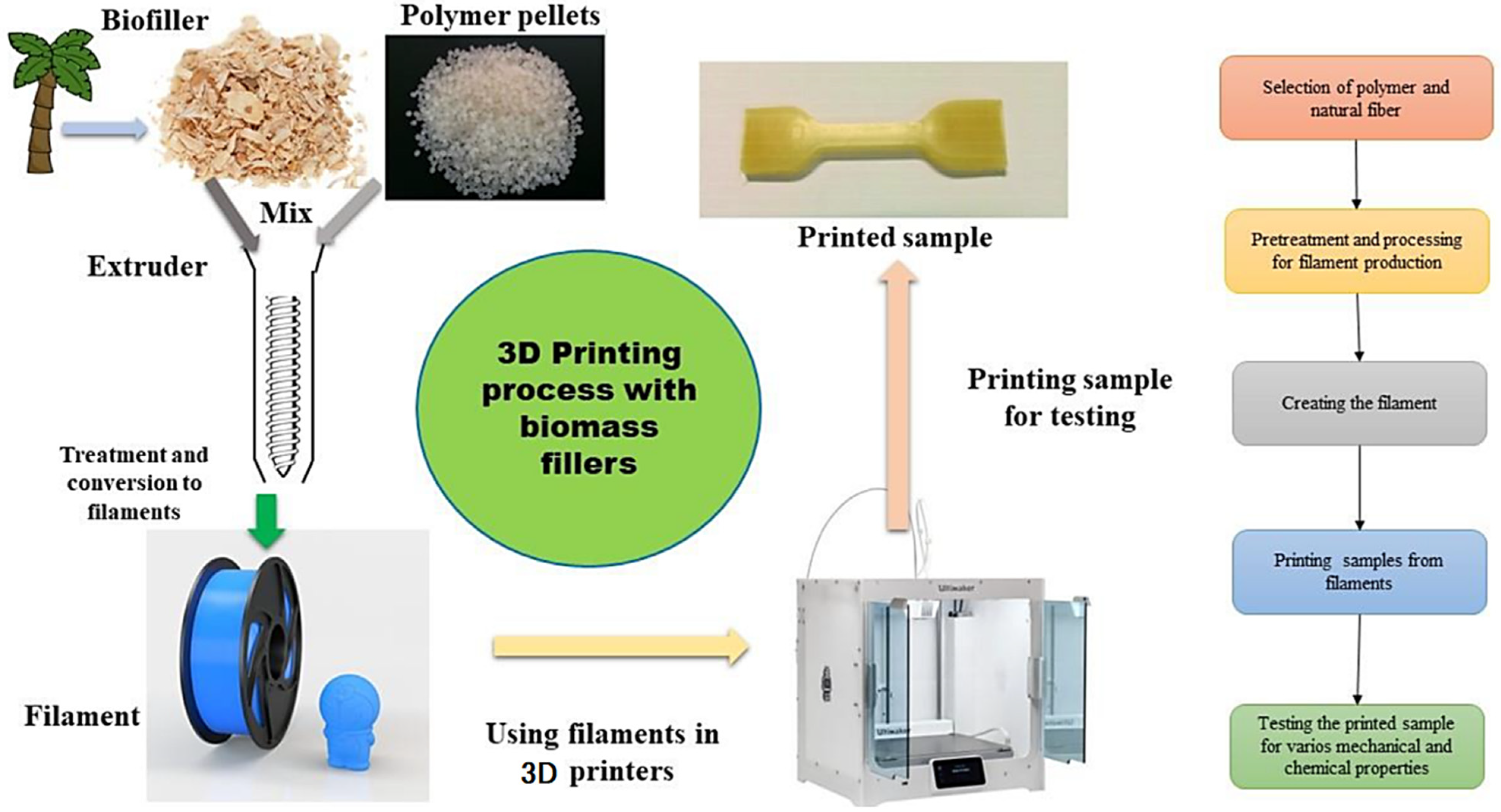
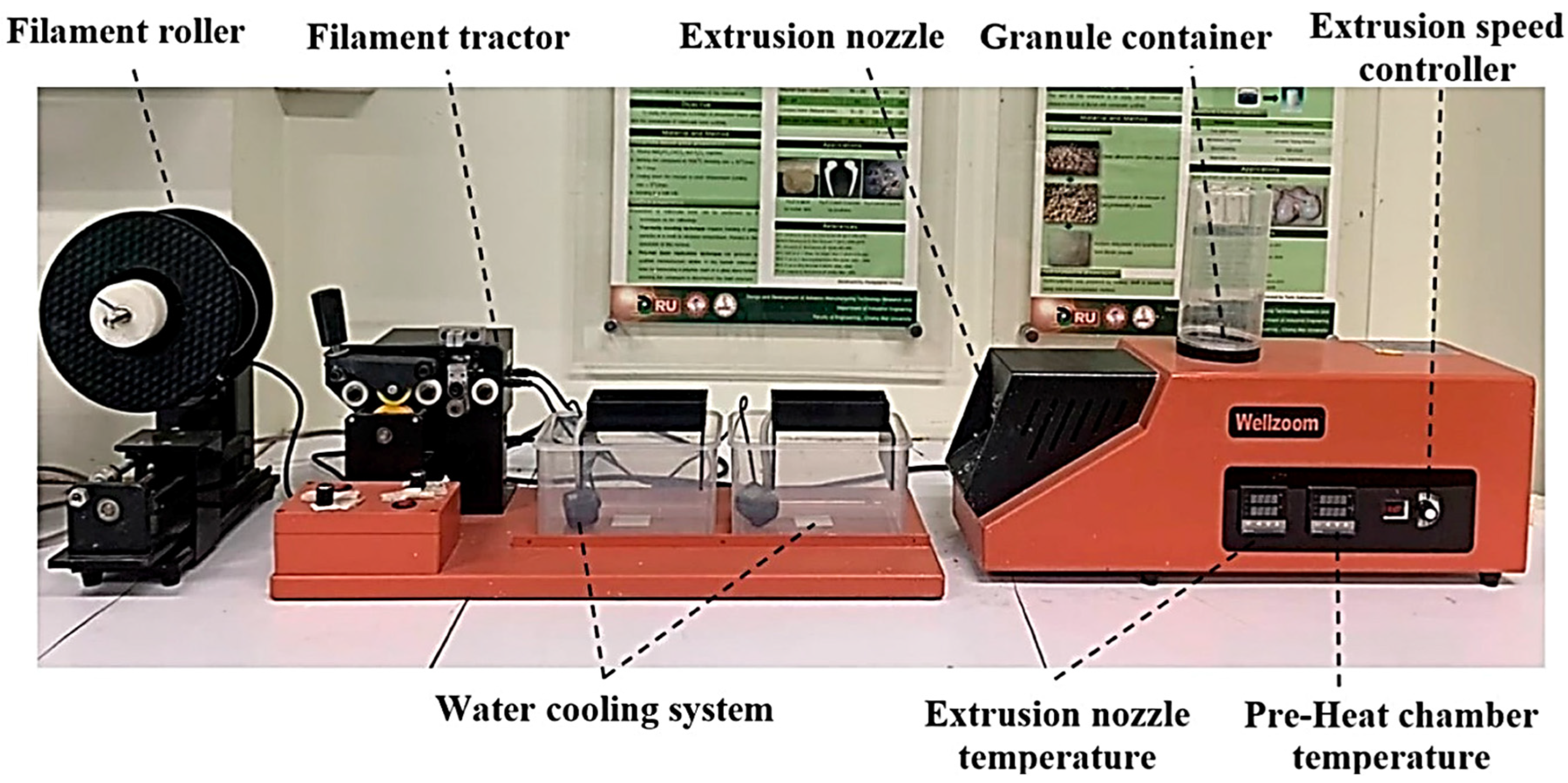

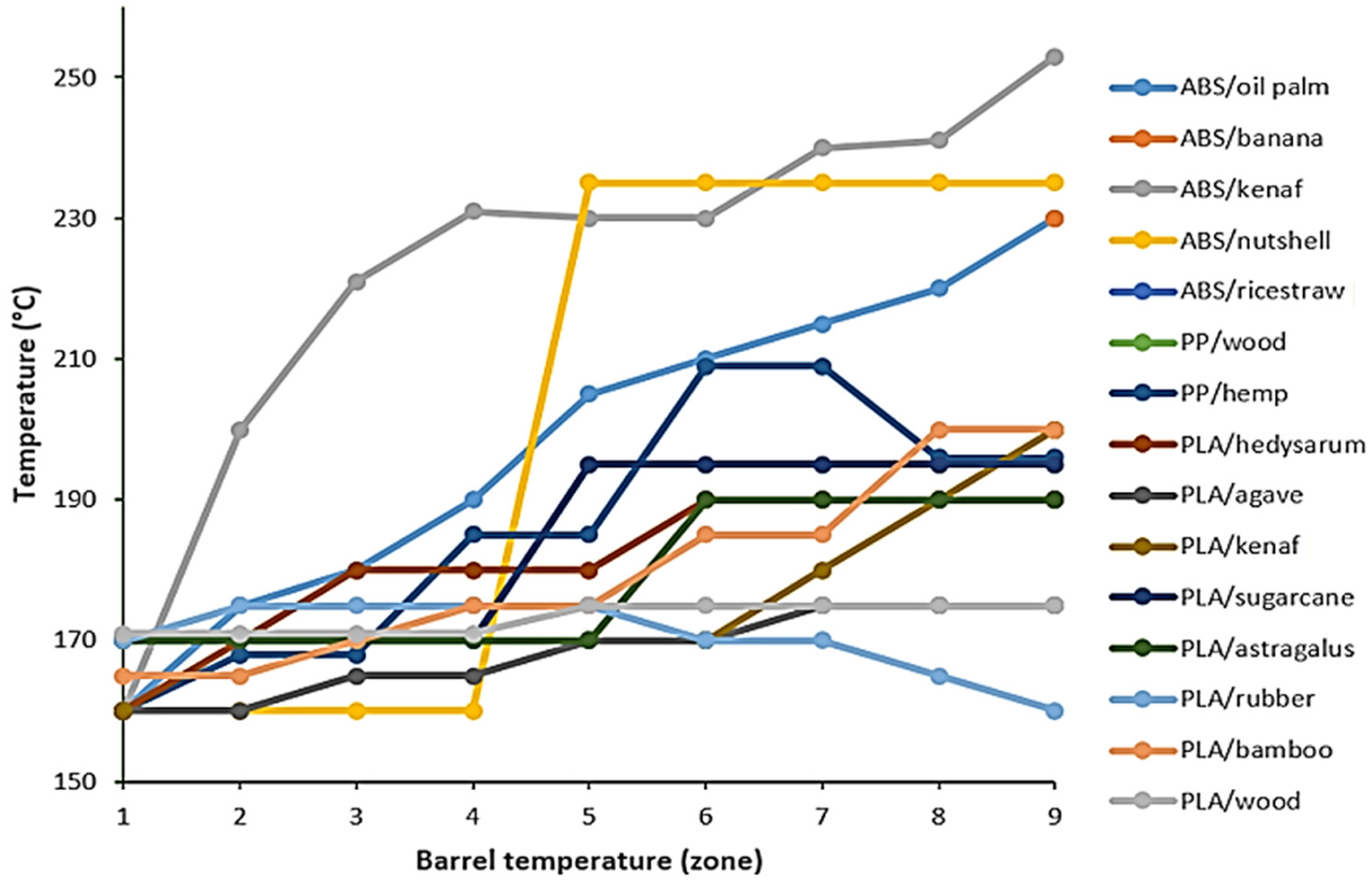
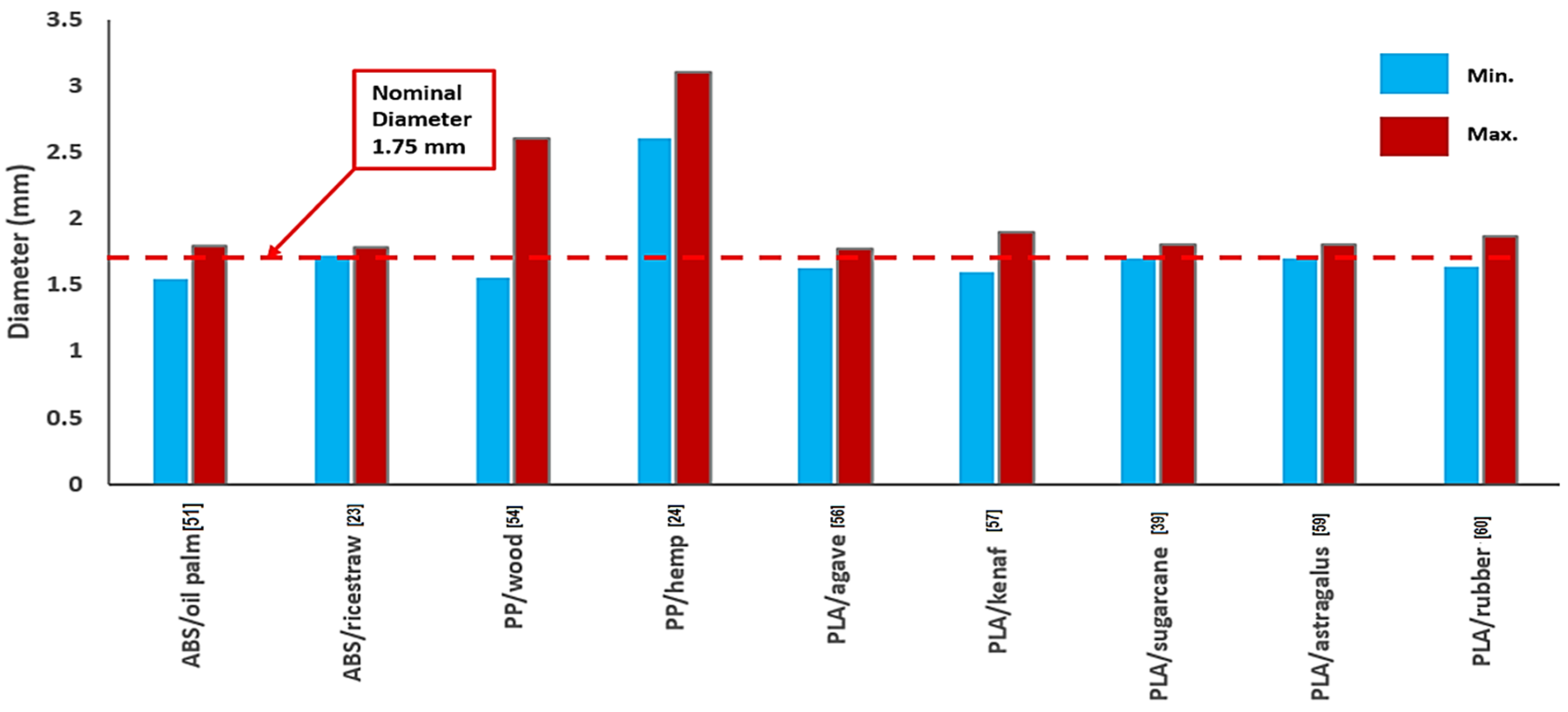
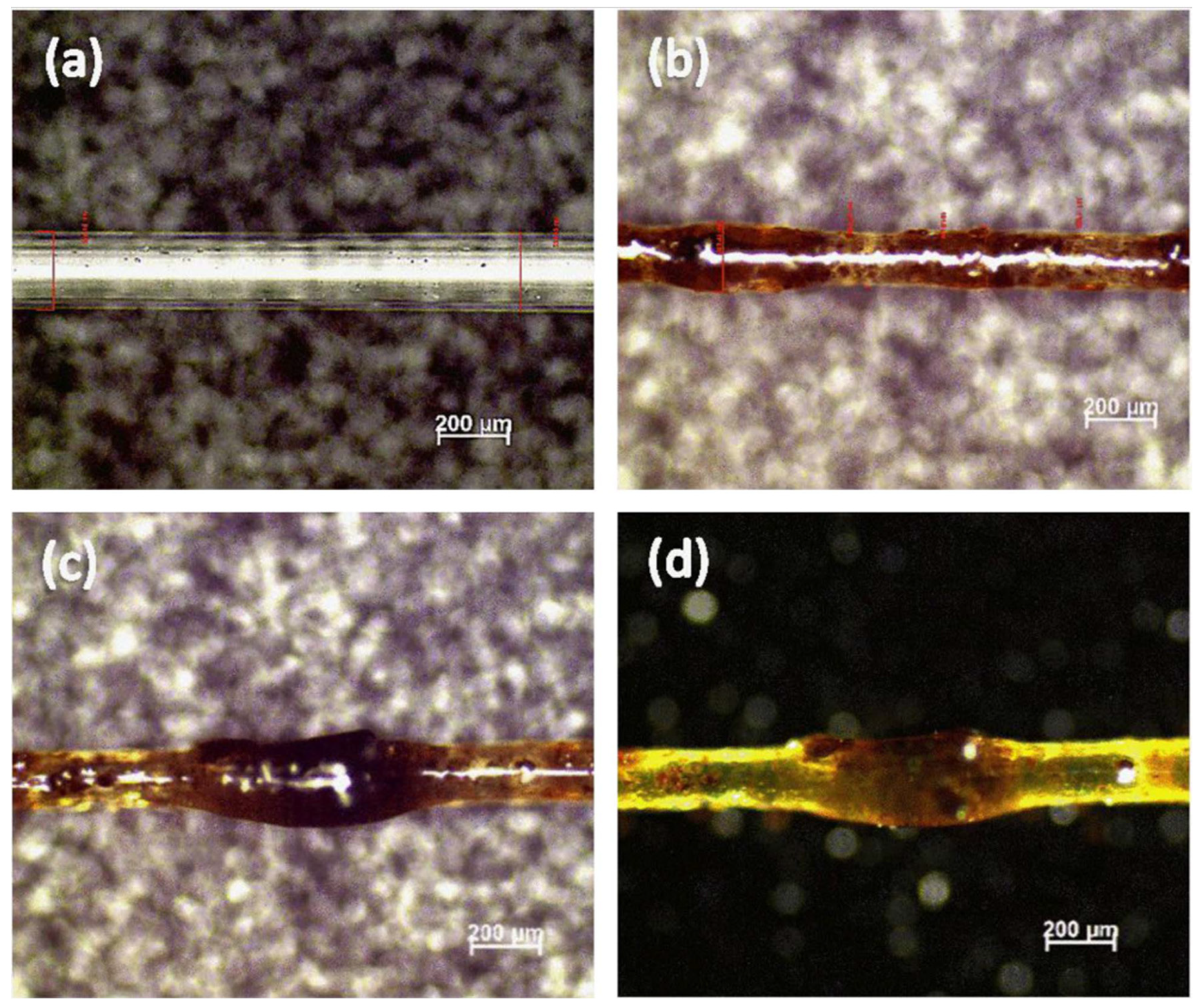

| Fiber | Density (g/cm3) | Tensile Strength (MPa) | Tensile Modulus (MPa) | Elongation at Break (%) |
|---|---|---|---|---|
| Sugar palm | 1.30 | 15.5–290 | 0.5–3.4 | 5.7–28 |
| Sisal | 1.50 | 400–700 | 9.0–38.0 | 2.0–14.0 |
| Oil palm | 1.55 | 400 | 9.0 | 18.0 |
| Jute | 1.60 | 393–800 | 10.0–30.0 | 1.2–1.8 |
| Kenaf | 1.45 | 930 | 53.0 | 1.6 |
| Hemp | 1.48 | 550–900 | 70.0 | 1.6–4.0 |
| Cotton | 1.60 | 287–800 | 5.5–12.6 | 2.0–10.0 |
| Bamboo | 1.25 | 290 | 17.0 | - |
| Flax | 1.50 | 345–1500 | 27.6 | 1.2–3.2 |
| Pineapple | 1.44 | 413–1627 | 60.0–82.0 | 14.5 |
| Banana | 1.35 | 529–914 | 27.0–32.0 | 5.9 |
| Matrix | Filler/Reinforcement | Wt.% | Extruder (Brand/Type) | Die Diameter (mm) | Filament Diameter Range (mm) | Printability (Yes/No) | 3D Printer | Ref. |
|---|---|---|---|---|---|---|---|---|
| ABS | Oil palm fiber | 0–7 | E23 Siemens/Twin screw | 1.75 | 1.54–1.79 | Yes | Flash Forge Creator Pro | [51] |
| ABS | Banana fiber | 0–5 | Customized/Twin screw | 1.50 | - | Yes | - | [52] |
| ABS | Kenaf fiber | 0–10 | HTGD-20/Twin screw | 1.75 | - | Yes | FlashForge | [41] |
| ABS | Macadamia nutshell | 0–29 | Customized/Single screw | - | - | Yes | Leapfrog Creatr | [53] |
| ABS | Rice straw | 0–15 | Customized/Single screw | 1.75 | 1.72–1.78 | Yes | Printrbot Simple Metal | [23] |
| PP | Wood Dust | 0–3 | Lab Tech/Twin screw | 1.75 | 1.55–2.60 | - | - | [54] |
| PP | Hemp | 0–30 | Lab Tech Scientific LTE20-44/Twin screw | 3.00 | 2.60–3.10 | Yes | Diamond Age | [24] |
| PLA | Hedysarum coronarium | 0–20 | Haake Technik/Single screw | 1.75 | - | Yes | Sharebot, Next Generation | [55] |
| PLA | Agave fiber | 0–10 | Leistritz Micro/Twin screw | 1.75 | 1.63–1.77 | Yes | Wanhao Duplicator | [56] |
| PLA | Kenaf fiber | 0–7 | Well zoom/Single screw | 1.75 | 1.60–1.90 | Yes | FlashForge Creator Pro | [57] |
| PLA | Kenaf fiber | 0–2.5 | Customized/Twin screw | 1.75 | - | Yes | FlashForge Creator Pro | [58] |
| PLA | Sugarcane fiber | 0–15 | Polylab OS/Twin screw | 1.75 | 1.70–1.80 | Yes | Architect 3D | [39] |
| PLA | Astragalus | 0–15 | SHJ-20, Nanjing Giant Machinery/Twin screw | 1.75 | 1.70–1.80 | Yes | Moshu S108 | [59] |
| PLA | Rubber | 0–20 | Labtech LTE 20–44/Twin screw | 1.75 | 1.64–1.86 | Yes | Craftbot Plus | [60] |
| PLA | Bamboo | 0–15 | Leistritz ZSE/Twin screw | - | - | Yes | Low cost 3D printer | [61] |
| PLA | Wood | 0–5 | Wellzoom LLC/Single screw | 1.75 | - | Yes | Shenzhen 603S | [21] |
| PLA | Soybean hulls | 0–10 | Leistritz/Twin crew | 1.75 | 1.74–1.76 | Yes | MakerBot Replicator Z18 | [62] |
| Matrix | Filler | Wire Pull Test/UTM | Density/Porosity Test | Results | Ref. |
|---|---|---|---|---|---|
| ABS | Oil palm fiber | Shimadzu Autograph (AGSX), ASTM638 | Archimedes principle (ASTM D3800) | Tensile strength was increased by 60% by going from 0.15 to 0.4 MPa of fibre loading. After that, the Young’s modulus increased by 22.8%, from 16.1 to 18.3 MPa. As the fiber loading was increased from 3 to 7 wt%, the density of extruded filament decreased and the percentage of porosity rose. | [51] |
| ABS | Nutshell | - | Archimedes principle | The two nutshell composite samples’ densities are much lower than those of pure polymer filaments and commercial woodfill. It is clear that when 29% nutshell is added, the density is reduced by more than 27.4% compared with pure ABS. | [53] |
| PP | Wood dust | AI-7000-LAU Go-Tech, ISO 3341 | ASTM D792-91 | According to the results, treated silane has a filament strength that is higher than r- PP’s. The findings show that the silane pretreatment of the wood fiber improves the interaction between it and the recycled PP. | [54] |
| PLA | Kenaf | Instron 3382 | Densimeter (Mettler Toledo) | The sample becomes less dense when the filler content rises from 3 to 7 wt%. Tensile strength starts to decline as fiber loading rises. That is as a result of the filler and matrix’s insufficient bonding. | [57] |
| PLA | Bamboo | Instron 5567 | Computed tomography (Phoenix Nanotom 180) | The compounded fibers’ length to diameter ratio had an effect on the filament’s modulus. Long bamboo fibers added to the PLA filament enhanced its stiffness by 215%, compared with a 39% rise for the dust-like fractions. Less porosities are present in every filament developed for this study compared with commercial filament. The porosities can be decreased to levels between 0 and 4% by anticipating appropriate drying. | [61] |
| PLA | Hemp | Instron 4484 | - | The filaments initially act elastically up to 18–20 MPa, but as the test goes on, the filaments behave viscoelastically. Tensile modulus is between 1500 and 1575 MPa, and it breaks between 25 and 30 MPa. | [69] |
Disclaimer/Publisher’s Note: The statements, opinions and data contained in all publications are solely those of the individual author(s) and contributor(s) and not of MDPI and/or the editor(s). MDPI and/or the editor(s) disclaim responsibility for any injury to people or property resulting from any ideas, methods, instructions or products referred to in the content. |
© 2023 by the authors. Licensee MDPI, Basel, Switzerland. This article is an open access article distributed under the terms and conditions of the Creative Commons Attribution (CC BY) license (https://creativecommons.org/licenses/by/4.0/).
Share and Cite
Ahmad, M.N.; Ishak, M.R.; Mohammad Taha, M.; Mustapha, F.; Leman, Z. A Review of Natural Fiber-Based Filaments for 3D Printing: Filament Fabrication and Characterization. Materials 2023, 16, 4052. https://doi.org/10.3390/ma16114052
Ahmad MN, Ishak MR, Mohammad Taha M, Mustapha F, Leman Z. A Review of Natural Fiber-Based Filaments for 3D Printing: Filament Fabrication and Characterization. Materials. 2023; 16(11):4052. https://doi.org/10.3390/ma16114052
Chicago/Turabian StyleAhmad, Mohd Nazri, Mohamad Ridzwan Ishak, Mastura Mohammad Taha, Faizal Mustapha, and Zulkiflle Leman. 2023. "A Review of Natural Fiber-Based Filaments for 3D Printing: Filament Fabrication and Characterization" Materials 16, no. 11: 4052. https://doi.org/10.3390/ma16114052
APA StyleAhmad, M. N., Ishak, M. R., Mohammad Taha, M., Mustapha, F., & Leman, Z. (2023). A Review of Natural Fiber-Based Filaments for 3D Printing: Filament Fabrication and Characterization. Materials, 16(11), 4052. https://doi.org/10.3390/ma16114052








